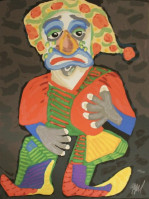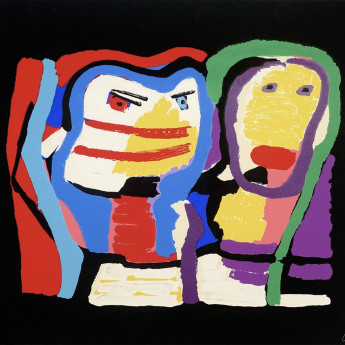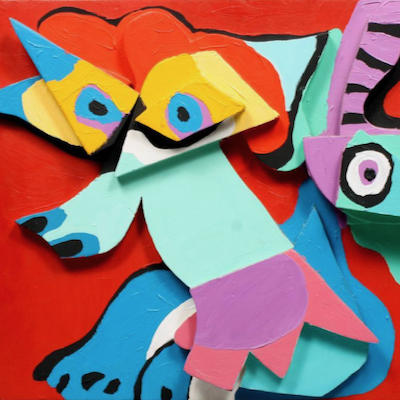
Details
Artist
Styles
Van de Loo 407 - From the series ‘Etudes et Surprises’ - Color woodcut - Signed and dated. // Dans le Sillage d’if-Aube by Asger Jorn, created in 1971, is a vibrant woodcut print that encapsulates the artist’s abstract expressionist style. The composition features a landscape rendered in bold, segmented colors, with a rich palette of blue, yellow, and red hues. Figures are subtly integrated into the scene, with flowing lines suggesting human forms in various positions, adding a layer of narrative to the abstract landscape. The interaction of colors and forms creates a sense of movement and dynamism, embodying the spontaneity and raw energy that is characteristic of Jorn’s work. This piece, part of his series Etudes et Surprises, is marked by the artist's unique approach to abstraction, where color and shape are primary vehicles of expression. Measuring 32.5 cm by 25 cm, this limited edition woodcut invites viewers to immerse themselves in a world of fluidity, emotion, and imagination.
Dans le Sillage d’if-Aube, 1971
form
Medium
Size
32.5 x 25 cm
- Inches
- Centimeters
Edition
Price
Details
Artist
Styles
Van de Loo 407 - From the series ‘Etudes et Surprises’ - Color woodcut - Signed and dated. // Dans le Sillage d’if-Aube by Asger Jorn, created in 1971, is a vibrant woodcut print that encapsulates the artist’s abstract expressionist style. The composition features a landscape rendered in bold, segmented colors, with a rich palette of blue, yellow, and red hues. Figures are subtly integrated into the scene, with flowing lines suggesting human forms in various positions, adding a layer of narrative to the abstract landscape. The interaction of colors and forms creates a sense of movement and dynamism, embodying the spontaneity and raw energy that is characteristic of Jorn’s work. This piece, part of his series Etudes et Surprises, is marked by the artist's unique approach to abstraction, where color and shape are primary vehicles of expression. Measuring 32.5 cm by 25 cm, this limited edition woodcut invites viewers to immerse themselves in a world of fluidity, emotion, and imagination.
What is the CoBrA movement?
CoBrA stands for Copenhagen, Brussels, and Amsterdam; the group was formed with a desire to break away from the existing art movements of the time. Their critique of Western society led them to experiment and evolve into a significant international movement. CoBrA was founded on November 8, 1948, at the Notre Dame Café in Paris, where its manifesto was signed by Karel Appel, Joseph Noiret, Corneille, Christian Dotremont, Constant, and Asger Jorn. The group was united by a shared commitment to freedom in both form and color, and their work emphasized experimentation and spontaneity.












